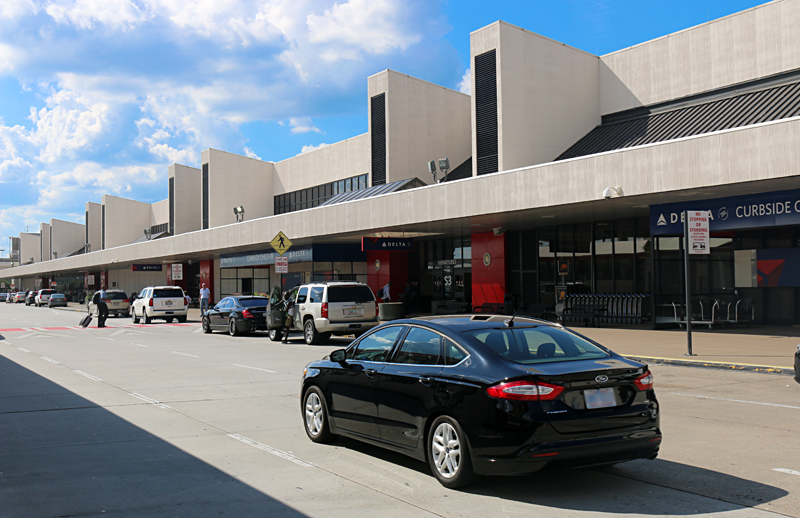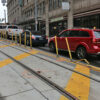Dropping off or picking up someone at the airport is stressful enough, as you want to be there in as little time as possible while ensuring that the person walks right out of the terminal and into your vehicle; but you have to contend with traffic congestion, law enforcement officers threatening to write you a citation if you do not move your vehicle, and the cost of parking the car if curbside pick-up is not an option — if parking spots are even available…
Would You Pay a Fee to Drop Off or Pick Up a Passenger At the Airport?
…but if airports started charging fees simply for motorists to have access to drop off or pick up a passenger at a terminal, the purported results would be increased revenue for the airport; reduced traffic congestion by encouraging more people to use high occupancy vehicles and public transportation; improved air quality — and drivers eventually absorbing the extra costs into their budgets, eventually nonchalantly treating the fee as just another toll or tax and simply factor it into the cost of travel.
Not everyone is convinced of those results, however. One such person is reportedly Thomas Glynn, who is the chief executive officer of the Massachusetts Port Authority — which is more popularly and commonly known as Massport.
“The Massachusetts Port Authority has agreed to study imposing a fee on drivers who pick up or drop off passengers at Logan International Airport, part of a deal with environmentalists seeking to curb congestion and air pollution amid a surge in airline traffic”, according to this article written by Adam Vaccaro of The Boston Globe. “Each day, more than 20,000 cars enter Logan to leave friends or relatives at a terminal or meet their arriving flights, according to Massport.”
Greater than 20 percent of the drivers of the approximately 108,000 vehicles entering the airport are dropping off a friend or family member — but if they all had to pay for the privilege of doing so, the number of those trips could be reduced, according to The Conservation Law Foundation.
“Logan Airport hasn’t been allowed to add commercial parking spaces since 1975, when a freeze on new spaces was enacted to combat the region’s (and country’s) air pollution problem. The freeze was meant to help bring eastern Massachusetts into compliance with air quality standards established by the federal Clean Air Act”, according to this article written by Rafael Mares, who is a vice president of the environmental group in Boston. “Over the last 40 years, however, passengers at Logan have skyrocketed 220 percent, putting a significant strain on its 21,088 parking spaces, especially during peak travel periods. Public transit options to the airport also haven’t kept up with demand, despite the welcome introduction of direct Silver Line service in 2005. To address these constraints, earlier this year Massport formally proposed lifting the freeze and adding 5,000 parking spaces.”
The addition of those parking spaces is expected to cost approximately $250 million under the condition that other measures to reduce auto emissions at the airport are considered and researched. The study by Massport is expected to be completed sometime by July 2019.
Not only has traffic congestion increased exponentially over the years; but the air quality — and the quality of life in general — for residents who live in communities which surround the airport has been compromised.
“With traffic growth in and out of Logan showing no signs of slowing down, we can’t ignore any solutions with the potential to save passengers time while also curbing the air and climate pollution associated with frequent drop-offs and pick-ups. Passthrough rates have been put into effect in other busy airports and it is prudent to at least explore the potential impacts of a similar program here in Boston”, according to this article written by Carol Gregory for The Conservation Law Foundation. “There is no doubt that Massport is facing a major challenge in managing ground transportation to the airport as passenger volumes increase. Our goal is that, through this multi-pronged approach, we can boost public transit and ride-share options for city and suburban residents, while also addressing the concerns around greenhouse gas, soot, and smog emissions that burden residents of neighboring communities.”
Another study by Massport will research the effectiveness of variable-rate pricing at the busy airport.
Tolls Considered as Airport Fees?
Although avoiding paying up to $2.05 in tolls each way for noncommercial vehicles with two axles through three different tunnels — the Sumner, Callahan and Ted Williams tunnels — for access between the airport and points south and west is not impossible, doing so can still be difficult, as the tunnels are far more convenient and save time…
…that is, if traffic is not clogging them. I have used all three tunnels numerous times — and I can understand why many people seem to think that the tolls for the tunnels is already considered as fees to access the airport.
At $1.55 each way, the Tobin Bridge is a less expensive option; but my experience has been that it is less convenient for access to and from Logan International Airport.
Add to the fact that all of the bridge and tunnel tolls are now electronic — motorists pay $1.50 each way through the tunnels and $1.25 via Tobin Bridge each way with EZPass — and that potentially introduces a whole new set of problems…
…especially if you rent a car to access Logan International Airport — or any other place in the world where electronic tolling systems are in use.
Not the First Airport in the United States to Charge an Access Fee
Logan International Airport would not be the first airport in the United States to charge a fee to motorists to enter the airport. Using TollTag, motorists are charged a minimum of two dollars to drive into Dallas-Fort Worth International Airport if they stay between eight minutes and 30 minutes — which is the typical amount of time needed to pick up or drop off a passenger. Fewer than eight minutes increases the charge to four dollars as a “penalty” of sorts on the assumption that drivers are using International Parkway to cut north or south through the airport to save time.
Fees have been in effect at that airport since it opened four decades ago.
A similar system of charging motorists for merely accessing the airport is already in effect in some airports in other countries around the world. Fees at greater than a dozen airports in the United Kingdom can range from $1.30 to five dollars, which some people believe is too low of a cost to deter more motorists from accessing the airports and think that $15.00 may realistically be a more effective fee to charge to change the behavior of motorist.
Summary
How many times have we heard over the years about how travelers — such as you and I — will simply factor in yet another nominal fee as part of the increased cost in traveling?
Not only do we already pay a plethora of taxes and fees for air travel, lodging and renting cars — including such ludicrous fees as mandatory resort fees and carrier-imposed fees, which are both designed primarily to purposely deceive the customer into an advertised price which is lower than what will be the actual total cost — but those taxes and fees have a tendency to keep increasing as though travelers are treated like some unlimited trough of income.
Options do abound if additional airports started charging access fees to motorists — such as the passenger parking his or her own vehicle at or near the airport; buses, trains and other forms of public transportation; taxi cabs; ride-sharing services such as Uber or Lyft as several examples — but not all options are available to everyone everywhere due to a lack of infrastructure or a cost which may be too high.
As of now, I am against such a fee — if only because it seems to be like placing a small bandage on a gaping wound by penalizing motorists rather than actually solve a problem…
…but I am willing to keep an open mind — especially if a return on investment offers value in terms of eventual cost savings, reduced time to pick up and drop off passengers, greater efficiency, and a significant improvement to the environment in general…
…instead of just another “money grab” at the expense of travelers.
Photograph ©2016 by Brian Cohen.

